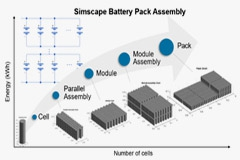MATLAB and Simulink R2022b Offers New Simscape Battery and Updates to Simplify and Automate Model-Based Design
The platform version also includes the new Medical Imaging Toolbox, which provides an end-to-end medical image analysis workflow
MathWorks announced today the release of version 2022b (R2022b) for the MATLAB® and Simulink® product family. R2022b introduces two new products and several enhancements that simplify and automate model-based design, helping engineers and researchers achieve product innovation and breakthroughs for their organizations.
The global battery management systems market size is expected to reach USD 13.4 billion in 2026. According to Bloomberg New Energy Finance, the growth is largely attributable to the development of the electric vehicle (EV) market. The organization's latest report shows that by 2040, 58 percent of global passenger car sales will come from electric vehicles. One of the major innovations introduced in Release R2022b, Simscape Battery™ provides design tools and parametric models for companies designing these types of battery systems.
Engineers and researchers can use Simscape Battery to create digital twins, run virtual tests of battery pack architectures, design battery management systems, and evaluate battery system behavior under normal and fault conditions. The tool can also automatically create a simulation model that matches the desired battery pack topology and includes cooling plate connections to evaluate electrical and thermal responses.
Diagram
Description automatically generatedDiagram, schematic
Description automatically generated
Legend: Design and simulate battery and energy storage systems using Simscape Battery.
Graham Dudgeon, principal product manager for electrical systems modeling at MathWorks, said: "We are excited to introduce Simscape Battery at a time when innovation in battery management systems is at an all-time high. This product includes a number of design tools designed to simplify and automate model-based design, including batteries Pack Model Builder, a tool that enables engineers to interactively evaluate different battery pack architectures."
R2022b also provides the new Medical Imaging Toolbox. This toolbox provides tools for designing, testing, and deploying diagnostic and radiomics algorithms using deep learning networks for medical imaging applications. Medical researchers, scientists, engineers, and device designers can use Medical Imaging Toolbox for multi-volume 3D visualization, multimodal registration, segmentation, and automatic ground-truth labeling to train deep learning networks on medical images.
Legend: Medical Imaging Toolbox can support interactive data annotation, semi-automatic or fully automatic medical image data annotation, and export the annotation results for medical imaging AI development.
Legend: Medical Imaging Toolbox provides classical or deep learning algorithms to segment 2D images or 3D objects into different regions, such as bones, tumors or other organs, and evaluate the accuracy of region segmentation.
"Medical engineers and researchers will greatly benefit from 3D annotation apps and the power of algorithms for the complete medical image analysis workflow including I/O, preprocessing, training and analysis," said Bruce Tannenbaum, Technical Product Marketing Manager, MathWorks , "We are excited to support a deep learning full workflow to automatically find objects of interest in images for tissue segmentation and disease detection."
R2022b introduces updates for the following popular MATLAB and Simulink tools, including:
- AUTOSAR Blockset: Develop service-oriented applications using a client-server ARA approach and deploy them on an embedded Linux platform. The tool supports data types and interfaces in user-defined schema models.
- Fuzzy Logic Toolbox: Interactively design, analyze, and simulate Fuzzy Inference Systems (FIS) with the updated Fuzzy Logic Designer. In addition, this enhanced toolbox supports engineers and researchers to design Type 2 FIS using command line functions or fuzzy logic designer.
- HDL Coder: Generate optimized SystemC code from MATLAB for high-level synthesis (HLS) and use frame-to-sample conversion for model and code optimization.
- Model Predictive Control Toolbox: Use neural networks as predictive models for nonlinear model predictive controllers. Additionally, the toolbox now enables users to implement ISO 26262 and MISRA C compliant predictive controllers.
- System Identification Toolbox: Create deep learning-based nonlinear state-space models using regular differential equations (ODEs). Machine learning and deep learning methods can also be used to represent nonlinear dynamics in nonlinear ARX and Hammerstein-Wiener models.

